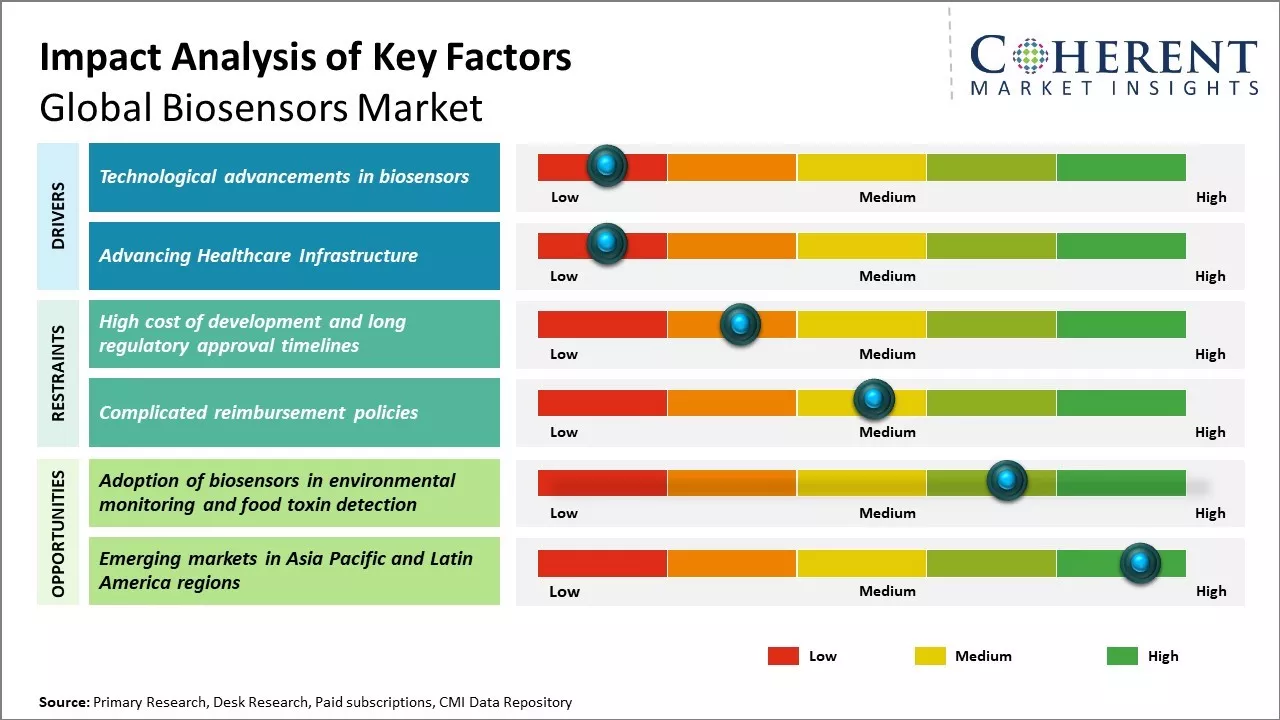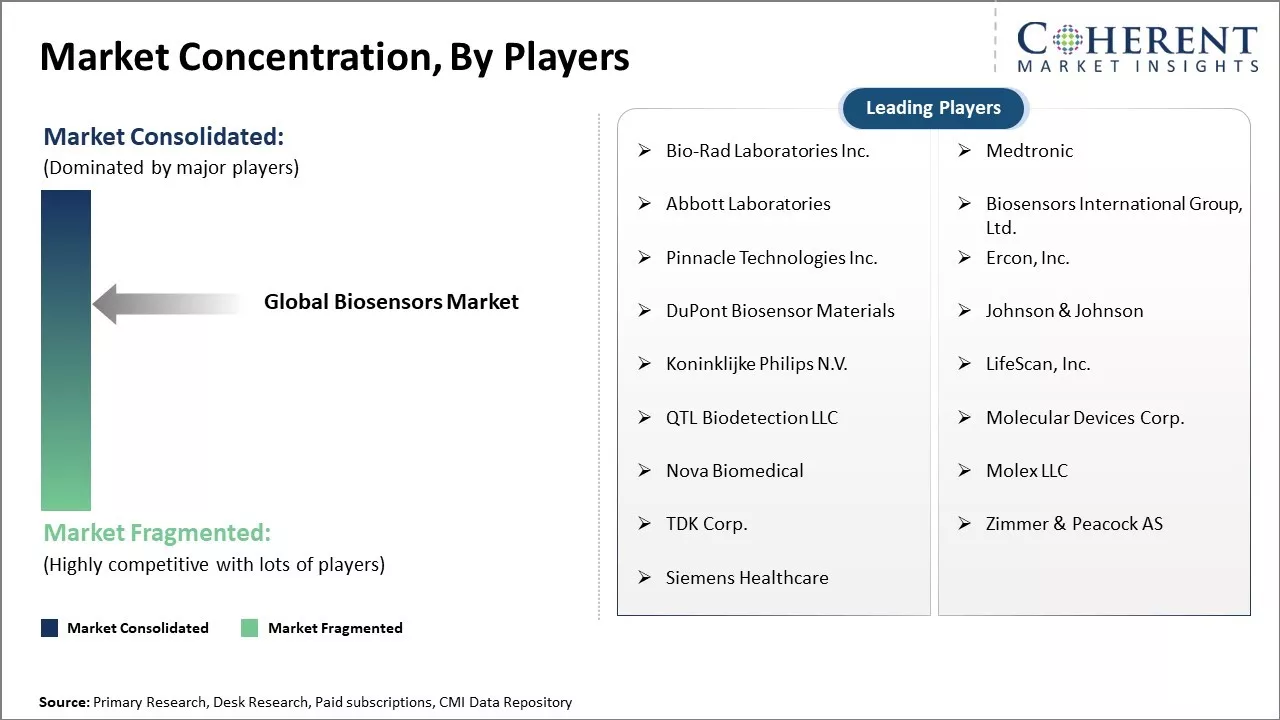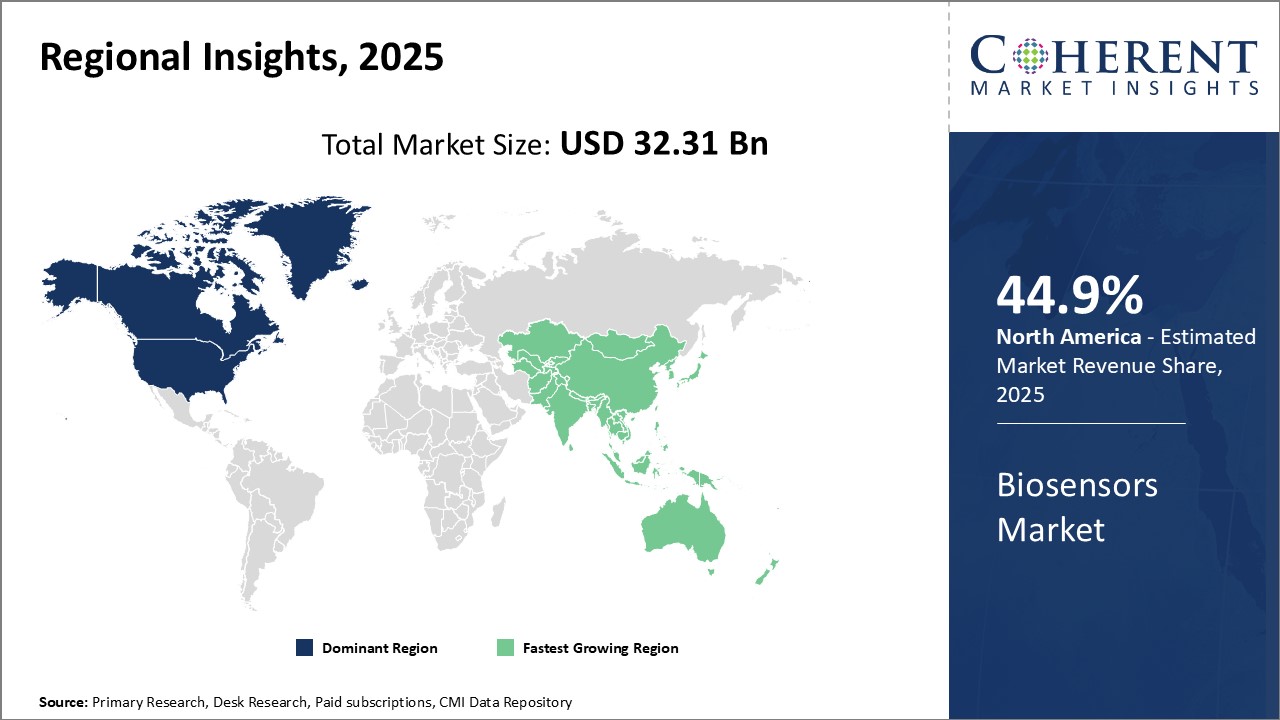The global biosensors market is estimated to be valued at USD 32.31 Bn in 2025 and is expected to reach USD 61.02 Bn by 2032, exhibiting a compound annual growth rate (CAGR) of 9.5% from 2025 to 2032.

To learn more about this report, Download Free Sample
The biosensors market is likely to witness strong growth during the forecast period driven by growing demand for rapid and precision diagnostic devices and the growing incidence of chronic conditions including diabetes, cardiovascular conditions, and cancer. Growing health awareness and adoption of wearable healthcare products are driving increased use of biosensors in clinical as well as non-clinical environments. The technology is also backed by advances in microfluidics and nanotechnology that enhance the mobility and sensitivity of biosensor devices.
|
Current Events |
Description and its impact |
|
Healthcare Digitization and Chronic Disease Management Fuel the Growth of Biosensors Market
|
|
|
Climate Regulations and Water Quality Issues Drive Environmental Biosensor Deployment
|
|
Uncover macros and micros vetted on 75+ parameters: Get instant access to report
Rising technological advancements in the field of biosensors are projected to significantly accelerate the growth of the global biosensors market in the coming years. Biosensors have emerged as an important diagnostic tool in healthcare due to their ability to rapidly detect biomarkers related to various health conditions.
Miniaturization of biosensor devices using microfabrication techniques has enabled development of wearable and portable sensors that can continuously monitor vital health parameters outside of clinical settings with high accuracy. This fosters opportunities for remote patient monitoring and management of chronic diseases.
For example, glucose biosensors used in continuous glucose monitoring systems have revolutionized diabetes management by eliminating the need for frequent finger pricking tests. On the molecular level, advancements in materials science and nanotechnology are allowing researchers to fabricate novel types of biosensor interfaces that exhibit enhanced sensitivity and selectivity.
In 2024, scientists from the University of California, San Diego, designed a revolutionary electronic finger wrap that can monitor health signs through sweat analysis. The device has no external power supply, and it powers itself with energy from the user's sweat, monitoring biomarkers like glucose, vitamins, and medications for personalized care and well-being management.

To learn more about this report, Download Free Sample
The healthcare sector across the globe has undergone rapid transformation over the past few years with technological advancements aimed at improving patient care and outcomes. The growing investments in digitizing healthcare infrastructure through telehealth, remote patient monitoring, and other connected care services have created significant opportunities for biosensor technologies.
Many developed as well as developing nations have recognized the need to strengthen primary care access and optimize public healthcare spending. This has driven initiatives toward decentralizing care and enabling early disease detection.
Biosensors that can facilitate non-invasive and frequent monitoring of vital health parameters are increasingly becoming invaluable tools to support such systemic changes. Wearable and mobile biosensors allow continuous tracking of symptoms, medication adherence, and other wellness indicators without requiring in-person visits. This helps manage chronic illnesses more efficiently and pick up health changes early.
Biosensors have tremendous potential in environmental monitoring and food safety applications. Environmental monitoring through biosensors allows for real-time, on-site detection of various pollutants in air, water and soil. This helps regulators and companies to take quick action and remediate pollution. For instance, biosensors can detect heavy metals, pesticides, antibiotic residues and other toxins in water bodies, thus helping to assess water quality.
Similarly, biosensor-based soil testing kits help farmers optimize fertilizer and pesticide use. This leads to sustainable agriculture and prevents contamination of groundwater. In food safety, biosensors provide a means to test for toxic residues and food-borne pathogens. According to the World Health Organization (WHO), nearly one in 10 people globally fall ill due to contaminated food and drinking water each year, resulting in 420,000 deaths.
Biosensors offer a simple, cost-effective solution by enabling point-of-care testing at farms, processing plants and packaging facilities. For example, biosensors are being used for on-site testing of milk samples to detect antibiotics in several countries according to the Food and Agriculture Organization (FAO) of the United Nations. This allows timely removal of contaminated produce and prevents their distribution in markets.
In terms of technology, the electrochemical segment is expected to contribute 40.6% of the market share in 2025 owing to continuous technological advancements. Electrochemical biosensors dominate the market as they offer high sensitivity, short response time, low cost of production and simple miniaturization. The electrochemical technique works on the principle of oxidation-reduction and is commonly used for testing blood glucose levels. Significant research is ongoing to improve the specificity,
stability and reliability of electrochemical biosensors. Nanoparticle-enabled electrochemical biosensors that combine the high surface area of nanoparticles with electrochemical transduction promise improved detection abilities. Integration of microfluidics with electrochemical biosensors allows for development of portable point-of-care testing devices with enhanced functionalities.
Another area attracting research interest is the development of wearable electrochemical biosensors for applications in healthcare monitoring and diagnosis. The rising demand for portable, easy-to-use and affordable diagnostic solutions will continue to propel the electrochemical segment in the coming years.
In terms of application, the medical testing segment is expected to hold 40.7% of the market share in 2025 driven by the increasing demand for point-of-care diagnostic tests. Traditional laboratory tests are being replaced by biosensors that provide rapid diagnoses outside healthcare facilities. The ability of biosensors to deliver instant results with minimum sample volume plays a crucial role in clinical decision making.
Conditions like cardiac markers, infectious diseases, therapeutic drug monitoring and cancers have seen widespread adoption of biosensor-based point-of-care tests. Self-monitoring of chronic diseases like diabetes through home-use glucose meters is another major application area.
Technological improvements providing multi-analyte detection capabilities from a single test are increasing the utility of biosensors in medical testing. The need for decentralization of healthcare and increasing prevalence of lifestyle diseases will continue stimulating medical biosensor usage.
In terms of end user, hospitals are expected to account for 30.8% of the market share in 2025 due to their mandate of delivering fast and reliable healthcare. The rising geriatric population who are prone to chronic illnesses require continual monitoring within hospital premises.
Biosensors enable effective patient management through real-time recording of vital signs and metabolic irregularities. Their ease of deployment and ability to automate workflows improve the efficiency of medical procedures in hospitals. Biosensor-based diagnostic aids assist in reaching accurate diagnosis faster. This helps optimize treatment costs and resource allocation.
Large hospitals are actively evaluating biosensors for applications like infection control, blood analysis, cardiac function testing, and screening of high-risk patients. As hospitals look to upgrade their facilities, biosensors can potentially replace traditional equipment and streamline operations.

To learn more about this report, Download Free Sample
North America has dominated the global biosensors market. The region is expected to account for 44.9% of the market share in 2025 and continues to be the largest regional market. Strong growth in the healthcare industry, coupled with heavy investments in biomedical research and development by both public and private players, has been a major factor driving the North American biosensors market. The region is home to several top biosensor technology companies and researchers.
Furthermore, the early adoption of advanced healthcare technologies along with stringent regulatory guidelines for new diagnostic tools have supported market expansion. Rising lifestyle diseases and growing emphasis on personalized medicine offer promising opportunities for further market penetration in the region.
The Asia Pacific region has emerged as the fastest growing market for biosensors in recent years. Countries like China, India, Japan and South Korea have shown tremendous progress in healthcare infrastructure and healthcare spending. This has boosted the demand for cutting-edge technologies across various medical application areas. Growing public awareness about chronic diseases, rapidly aging populations and increasing healthcare accessibility are some of the key socio-economic factors propelling the APAC biosensors market forward.
Export-focused manufacturing environments in these countries have also facilitated large-scale production of biosensor components at competitive prices. This has attracted several global market leaders to leverage opportunities in the region through partnerships with local players. The strong APAC market growth momentum is expected to continue in the foreseeable future, driven mainly by improving economy, rising affluence and government efforts to enhance public healthcare provision.
The U.S. dominates the biosensors market globally, sustained by the presence of a robust healthcare framework, sophisticated R&D base, and high adoption rates of wearable health devices. Giant corporations such as Abbott and Medtronic have their headquarters here, supporting innovation in glucometer monitoring, cardiovascular diagnosis, and point-of-care testing. Government grants and rising chronic disease incidence also reinforce market leadership.
Germany is Europe's biosensor center, enjoying a strong medical device sector, solidly rooted academic institutions, and increasing investment in precision diagnostic capabilities. The smart healthcare emphasis of the country and integration of biosensors within healthcare equipment have substantially enhanced its market share, particularly for diagnostic and biotechnology uses.
China is growing fast in the biosensors market because of significant investment in local manufacturing, healthcare modernization, and its booming biotech industry. With intensified government support for digital health programs and a massive population size, growth in demand for diabetes monitoring, disease control of infectious diseases, and fitness tracking is increasing rapidly.
Japan has a robust presence in the biosensors market with its dominance of miniaturized electronics and aging population requirements. Compact, high-precision biosensors developed by Japanese companies in wearable devices and home care systems contribute to the sector's growth. Biosensors' integration in consumer electronics also enhances growth in the market.
| Report Coverage | Details | ||
|---|---|---|---|
| Base Year: | 2024 | Market Size in 2025: | USD 32.31 Bn |
| Historical Data for: | 2020 To 2024 | Forecast Period: | 2025 To 2032 |
| Forecast Period 2025 to 2032 CAGR: | 9.5% | 2032 Value Projection: | USD 61.02 Bn |
| Geographies covered: |
|
||
| Segments covered: |
|
||
| Companies covered: |
Bio-Rad Laboratories Inc., Medtronic, Abbott Laboratories, Biosensors International Group, Ltd., Pinnacle Technologies Inc., Ercon, Inc., DuPont Biosensor Materials, Johnson & Johnson, Koninklijke Philips N.V., LifeScan, Inc., QTL Biodetection LLC, Molecular Devices Corp., Nova Biomedical, Molex LLC, TDK Corp., Zimmer & Peacock AS, and Siemens Healthcare |
||
| Growth Drivers: |
|
||
| Restraints & Challenges: |
|
||
Uncover macros and micros vetted on 75+ parameters: Get instant access to report
Share
Share
About Author
Komal Dighe is a Management Consultant with over 8 years of experience in market research and consulting. She excels in managing and delivering high-quality insights and solutions in Health-tech Consulting reports. Her expertise encompasses conducting both primary and secondary research, effectively addressing client requirements, and excelling in market estimation and forecast. Her comprehensive approach ensures that clients receive thorough and accurate analyses, enabling them to make informed decisions and capitalize on market opportunities.
Missing comfort of reading report in your local language? Find your preferred language :
Transform your Strategy with Exclusive Trending Reports :
Frequently Asked Questions
Joining thousands of companies around the world committed to making the Excellent Business Solutions.
View All Our Clients